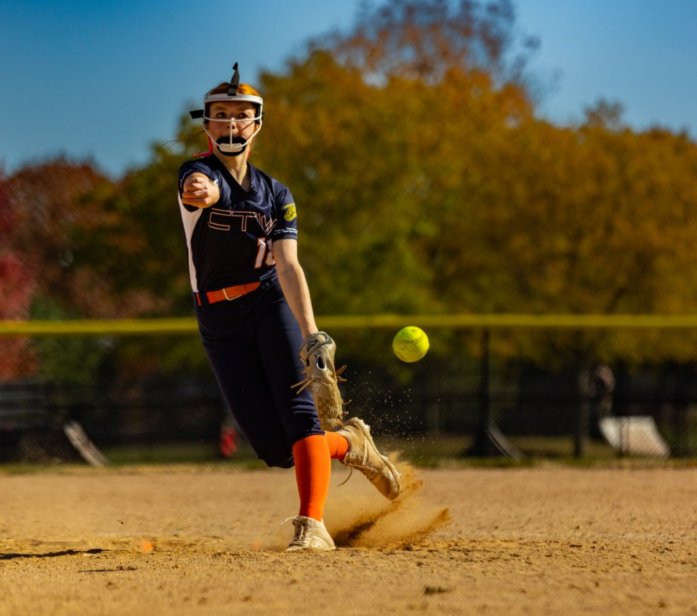
Recently my friend and fellow pitching coach Linda Lensch, a trainer with the NJ Ruthless and owner of Greased Lightning Fastpitch High Performance Instruction LLC attended an online presentation about how new technologies are improving and changing the game.
Linda was kind enough to share the PowerPoint of the presentation with a few of us pitching coaches. Included was some data, presented by Florida State assistant coach Troy Cameron, that came out of pitching tracking by YakkerTech at five D1 schools.
One of the things I found most interesting was the heat map on changeup locations and results, which you can see on the far left.

Notice how both the vast majority of pitch locations AND the vast majority of whiffs (swings and misses) aren’t on the corners. Instead, they are dead red.
I have been preaching this for years based on my own observations and experience, and have heard many college coaches say the same thing. You don’t have to be clever or try to paint the corners if you have an effective changeup. Just throw it down the middle, mid-thigh-high or below, and you’ll get the desired effect – a whiff.
Now we have the data to prove it.
I’ll say it again a little louder for those in the back, and for those who have been coaching he same way for 20 years and don’t like new information: YOU DON’T NEED TO PAINT THE CORNERS WITH A CHANGEUP. JUST THROW IT DEAD RED.
What does this mean from a practical standpoint?
For one, pitchers can quit wasting time trying to lean how to paint the corners with a changeup and instead focus their time on disguising the fact that it IS a changeup.
Most pitchers start out learning to throw different pitches down the middle, and then once they can do that will move on to moving them out. In this case, once a pitcher can throw it low and slow without giving it away in her motion she can move on to other pitches.
It also means coaches can quit insisting until their hair is on fire that their pitchers must be able to spot their changeups inside and out. Less stress for the pitcher and the pitch caller.
The pitchers’ parents can also relax in the stands if they see their daughters throwing changeups down the middle. It’s fine, dude or dudette. That’s where it’s most effective.
Why is it most effective down the middle? Now we get into speculation and theories, but I have a pretty good suspicion on that topic based on 20+ years of teaching that pitch.
The whole point of a changeup is to either induce a hitter to swing well ahead of the ball arriving at the plate or confuse her on what she’s seeing to the point where she lets the pitch go by before she can process it. The way you do that is by bringing the body and arm at one speed while having the ball travel at a different, slower speed. Easier said than done, by the way.
It’s like a reverse pitching machine. With a machine, the feeder’s arm usually moves glacially slow (and may even fumble putting the ball in the chute) while the pitch is delivered at 55, 60, 65, etc. mph. The arm speed and the pitch speed don’t match up, so the hitter is perpetually behind the pitch unless she know the keys to hitting off a machine.
With the changeup the opposite is true. The body and especially the arm are traveling through space at a rate of speed that matches the pitcher’s fastest pitch (usually the fastball), but the design of the pitch allows it to be delivered 12-15 mph slower than the fastest pitch without any visible clues that it will be slower.
That’s why you see hitters’ knees buckle when a well-thrown change comes at them. The visual clues and the reality don’t match up and they contort themselves into a pretzel trying to adjust on the fly.
And if you can do that as a pitcher, down the middle works just fine. In fact it’s probably preferable because it can fool umpires too, so why not make it easier for them to call?
Now, before anyone starts saying “Oh, that only works at the lower levels” remember where this data comes from. It comes from five colleges that tracked every pitch of their pitchers and their opponents during home games.
And since these are not cheap systems by any means, you can bet that these were some pretty big schools, i.e., ones you see on TV all the time. They’re the only ones with the budgets to afford it.
So if it works at that level, you can be pretty sure it will work at yours.
The data doesn’t lie. It’s all there in black and white and red.
Quit wasting time focusing on painting the corners with changeups and just turn your pitchers loose to deliver them where they will be most effective based on the data: dead red.
You’ll get better results. And your pitchers will have one less thing to worry about.
Credit : Source link








